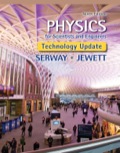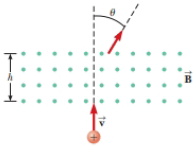
Concept explainers
Why is the following situation impossible? Figure P28.46 shows an experimental technique for altering the direction of travel for a charged particle. A particle of charge q = 1.00 μC and mass m = 2.00 × 10−15 kg enters the bottom of the region of uniform magnetic field at speed ν = 2.00 × 105 m/s, with a velocity vector perpendicular to the field lines. The magnetic force on the particle causes its direction of travel to change so that it leaves the region of the magnetic field at the top traveling at an angle from its original direction. The magnetic field has magnitude B = 0.400 T and is directed out of the page. The length h of the magnetic field region is 0.110 m. An experimenter performs the technique and measures the angle θ at which the particles exit the top of the field. She finds that the angles of deviation are exactly as predicted.
Figure P28.46

Trending nowThis is a popular solution!

Chapter 29 Solutions
EBK PHYSICS FOR SCIENTISTS AND ENGINEER
- Solve and answer the question correctly please. Thank you!!arrow_forwardSolve and answer the question correctly please. Thank you!!arrow_forwardWhen the motorcyclist is at A, he increases his speed along the vertical circular path at the rate of = (0.3t) ft/s², where t is in seconds. Take p = 360 ft. (Figure 1) Part A 60° Ρ B If he starts from rest at A, determine the magnitude of his velocity when he reaches B. Express your answer to three significant figures and include the appropriate units. v = Value Submit Request Answer ་ Part B ? Units If he starts from rest at A, determine the magnitude of his acceleration when he reaches B. Express your answer to three significant figures and include the appropriate units. 11 ? a = Value Unitsarrow_forward
- The car starts from rest at s = 0 and increases its speed at a₁ = 7 m/s². (Figure 1) Part A = 40 m Determine the time when the magnitude of acceleration becomes 20 m/s². Express your answer to three significant figures and include the appropriate units. ? t = Value Units Part B At what position s does this occur? Express your answer to three significant figures and include the appropriate units. s = Value Submit Request Answer ? Unitsarrow_forwardSolve and answer the question correctly please. Thank you!!arrow_forwardSolve and answer the question correctly please. Thank you!!arrow_forward
- Solve and answer the question correctly please. Thank you!!arrow_forwardSolve and answer the question correctly please. Thank you!!arrow_forwardr 2. Measuring Length mm 1 cm 2 3 INCH 1 16THS 5 6 7 8 9 10 11 FAIRGATE COLD SPRING, NEW YORK 2 3 12 1. Using the metric (top) scale only, what units are being used for the long lines with the numbers? Hint: Remember that 2.54 cm = 1 in. 2. What are the units of the small lines? 3. How many decimal places should be recorded using this tool? 4. What is the length of the red line? Note: Make sure to use the correct units and decimal places. 5. Now observe your ruler. What metric units are used on your ruler? 6. How many decimal places should you record when using your ruler? 7. Measure a box, book, coin and can and fill out the data table below. Make sure to use units and the correct number of decimal places for your ruler. Table 1: Measuring Length Data Table Object Length of the box Length Local PR Distribution Only $99/Release. Get Started On Our Website Now! V 2 217arrow_forward
 Principles of Physics: A Calculus-Based TextPhysicsISBN:9781133104261Author:Raymond A. Serway, John W. JewettPublisher:Cengage Learning
Principles of Physics: A Calculus-Based TextPhysicsISBN:9781133104261Author:Raymond A. Serway, John W. JewettPublisher:Cengage Learning Physics for Scientists and EngineersPhysicsISBN:9781337553278Author:Raymond A. Serway, John W. JewettPublisher:Cengage Learning
Physics for Scientists and EngineersPhysicsISBN:9781337553278Author:Raymond A. Serway, John W. JewettPublisher:Cengage Learning Physics for Scientists and Engineers with Modern ...PhysicsISBN:9781337553292Author:Raymond A. Serway, John W. JewettPublisher:Cengage Learning
Physics for Scientists and Engineers with Modern ...PhysicsISBN:9781337553292Author:Raymond A. Serway, John W. JewettPublisher:Cengage Learning College PhysicsPhysicsISBN:9781305952300Author:Raymond A. Serway, Chris VuillePublisher:Cengage Learning
College PhysicsPhysicsISBN:9781305952300Author:Raymond A. Serway, Chris VuillePublisher:Cengage Learning College PhysicsPhysicsISBN:9781285737027Author:Raymond A. Serway, Chris VuillePublisher:Cengage Learning
College PhysicsPhysicsISBN:9781285737027Author:Raymond A. Serway, Chris VuillePublisher:Cengage Learning





